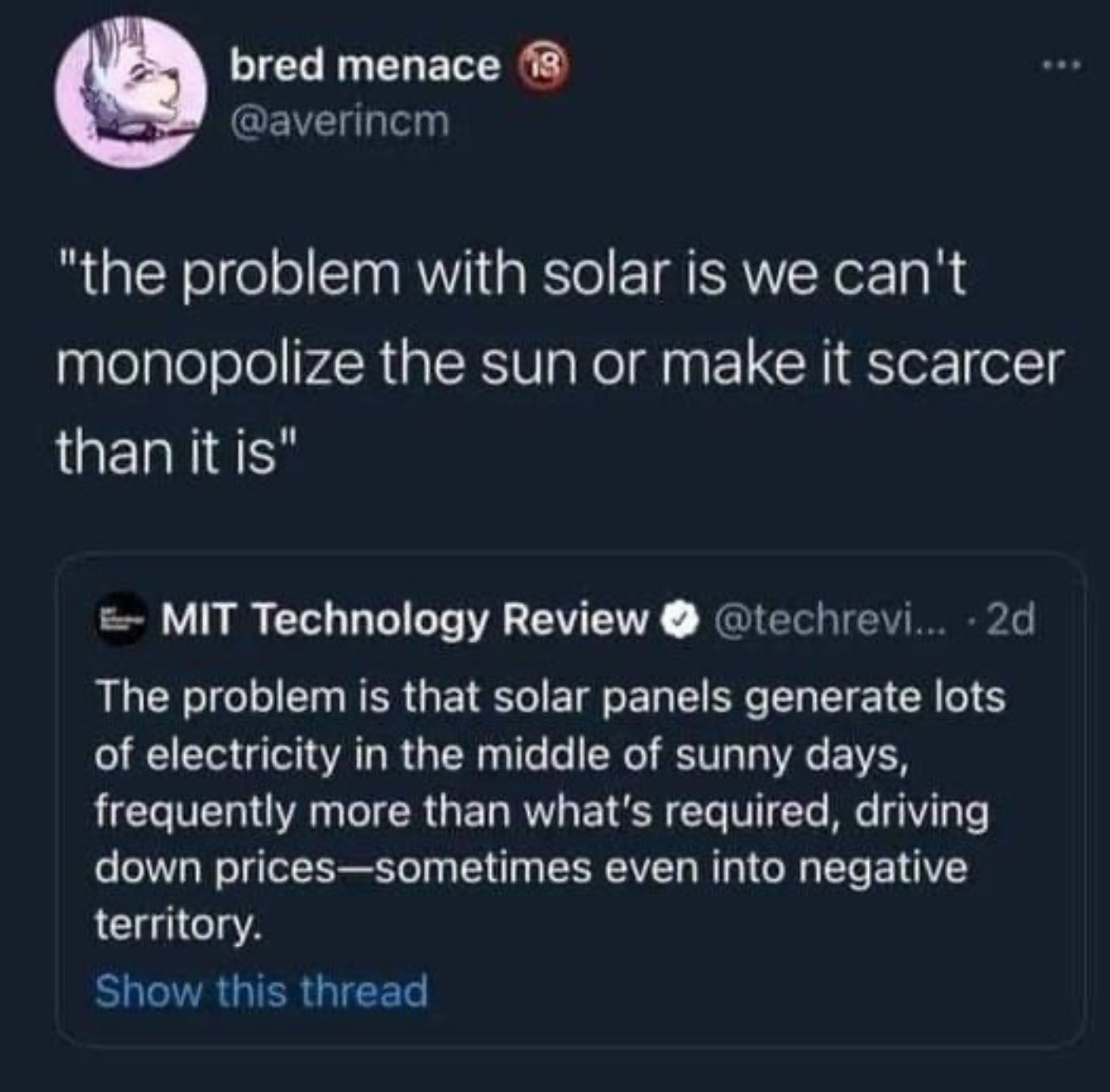this post was submitted on 02 Oct 2024
1686 points (95.6% liked)
Microblog Memes
6193 readers
2775 users here now
A place to share screenshots of Microblog posts, whether from Mastodon, tumblr, ~~Twitter~~ X, KBin, Threads or elsewhere.
Created as an evolution of White People Twitter and other tweet-capture subreddits.
Rules:
- Please put at least one word relevant to the post in the post title.
- Be nice.
- No advertising, brand promotion or guerilla marketing.
- Posters are encouraged to link to the toot or tweet etc in the description of posts.
Related communities:
founded 2 years ago
MODERATORS
you are viewing a single comment's thread
view the rest of the comments
view the rest of the comments

As someone with a technical background this is the stupidest problem with solar that I don’t get… just turn off the panels in groups until generation is closer to demand… how have engineers not figured that out. And if they have why does this still get written about.
Someone is an idiot. Maybe it’s me?
I’m adjacent to this problem, so I have a little context, but am not an expert at all.
To my knowledge, we don’t have granular control over panels. So we can shut off legs of a plant, but that’s a lot of power to be moving all at once.
Instead, prices are set to encourage commercial customers to intake more power incrementally. This has a smoother result on the grid, less chance of destabilizing.
A customer like a data center could wait to perform defragmentation or a backup or something until the price of power hits a cheap or negative number.
Thanks that’s helpful.
But right…?
Solar plants can be reduced to rationalize supply.
To my understanding. The bigger issue is you can’t as effectively do this with other non-renewables like coal/gas… so this not a solar problem but a problem of legacy power plants.
So stupid. The narrative as well.
Yea, more control over the panels will help with the overgeneration issue.
But there’s other issues like ramping supply to meet peak demand and general generation during non-solar hours that still have to be addressed.
Each have interesting proposals on how to solve them, but they haven’t been developed to the point that they’re ready to be put onto the grid at a large scale.
I'm in solar/BESS, and I mean more and more DER sites are making use of string inverters which break out arrays into greater chunks than with central inverters. With those, you have more granularity of control where you can drop entire blocks/strings at a time to fall to your curtailed export rate.
You might ask yourself though why DERs can't just ramp inverter outputs up or down to match curtailment automatically across a whole site. You can absolutely do that, but what happens is your solar or wind resource stays high on the DC or low frequency (LF) AC side, respectively, while power frequency AC is low on the other side of the inverters. This is referred to as DC:AC ratio in the biz, and the higher that ratio, the more losses your inverters experience and less efficient they are. This also puts a huge strain on your inverters and can lessen their operational lifetime.
But really, DERs tie into the grid at distribution level and so they don't fall under the regulations of FERC & NERC (at least in North America). This means that smaller producers don't have the same requirements for control as do utility-scale players, so the incentive to control these string inverters at that granular level isn't there. It's much easier to just trip the main breaker and wait until the utility gives you the go ahead to turn back on.
I suspect that at lot of producers may want to look into greater control capabilities in the future, but this also depends on inverter OEMs too allowing that control.